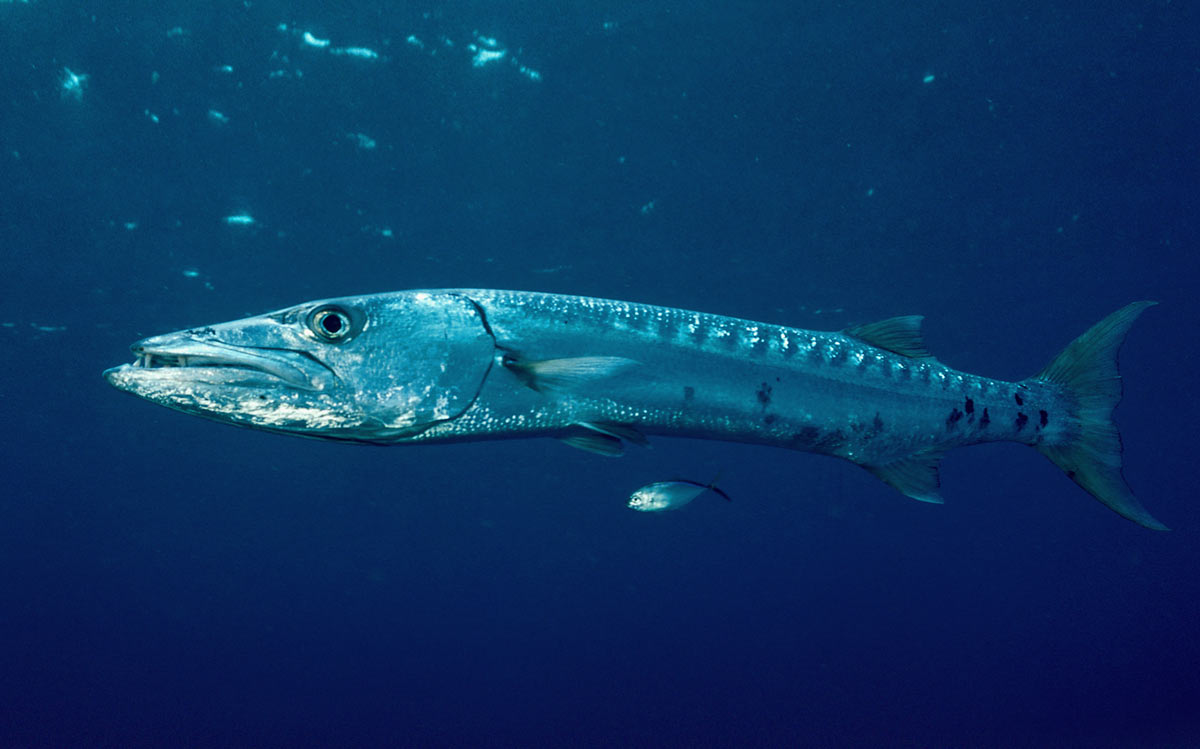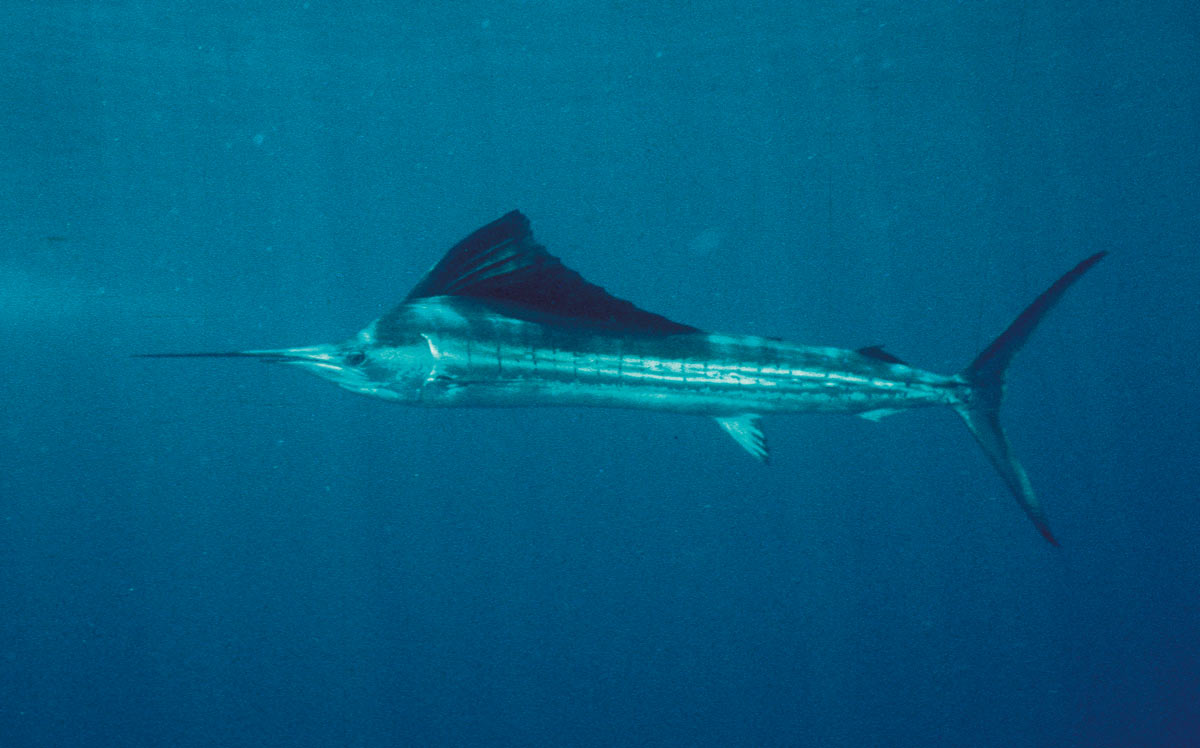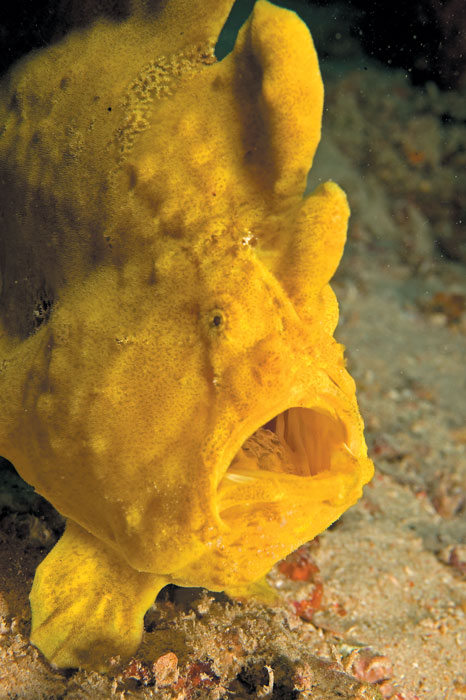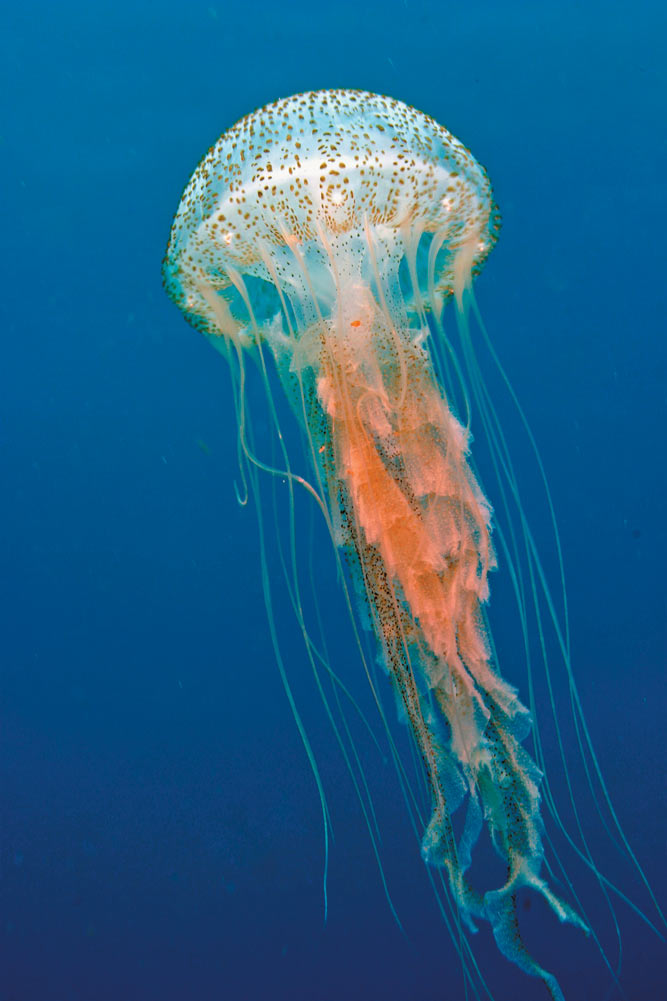Ask a group of football, basketball, soccer and baseball coaches what attributes they fear most in their opponents and look for when they build their own teams, and one of the more common answers would be speed. When creating game strategies coaches spend a lot of effort trying to cover up areas where their teams lack speed and figuring out the best ways to exploit opponents’ lack of speed. Create situations that match your fast guys against their slow guys and you gain significant advantages in many athletic contests.
The same is true in the underwater world. Speed often overcomes other advantages, or adaptations, in the real-life “game” of predator and prey.
In the animal world the term speed can be looked at in several ways. Certainly speed can be measured in terms of miles (or kilometers) per hour. Additionally, it can be viewed as how quickly an animal can kill its prey, and in the time an animal takes to recognize and react to a potential threat or opportunity. In this article we will learn about the natural history of some of the ocean’s swiftest swimmers, killers and defenders.

Studies have demonstrated that the slime layer on the surface of the great barracuda reduces drag by an astonishing 60 percent or more. Photo by Marty Snyderman.
Superb Swimmers
In terms of their overall shape, fishes are generally streamlined with a pointed snout and posterior and a broad propulsive tail. Unlike the human body, a fish’s shape is ideal for speeding through the water without creating excess resistance. This torpedo-shaped body is typical of the fastest-swimming fishes, billfishes and tunas. One billfish, the sailfish, is believed to be capable of swimming bursts of at least 70 mph (112 kmph). Tunas are built for long-distance endurance as well as speed, swimming as fast as 30 mph (48 kmph) and migrating as far as 7,700 miles (12,320 km) in only four months.
Other fishes come in a variety of shapes. Creatures such as eels, flatfishes, angelfishes, butterflyfishes and puffers are all slower swimmers that have bodies best adapted to their habitats. Unlike fishes that swim through the open water, these fishes have adapted to life in caves and crevices near the floors and walls of coral reef communities where speed is less important than camouflage, maneuverability or the ability to quickly slip into tight crevices.
Marine creatures also have to deal with the fact that water is roughly 800 times denser than air and water has a high viscosity. Viscosity is defined as the internal friction of a fluid and combined with the density, makes water much more difficult to move through than air. Salt water is even more dense and viscous than fresh water, so ocean animals have to work harder or be more efficient than their freshwater counterparts to attain the same speeds.
Two factors work against an animal’s speed in water. They are “drag” and “pressure resistance.” Drag is a byproduct of four factors: shape, the speed of the animal at any given instant, the nature of the surface or skin, and the nature of the flow of water over that surface. Studies have demonstrated that the faster the speed of travel, the greater the drag.
Pressure resistance is a function of shape and is the consequence of having to part and push water in front of a moving object while simultaneously forcing the water to flow around the body. Up to a point, the smoother the flow of water along the body of a moving animal, the less resistance, and the faster the animal can swim. However, perfectly laminar flow (flow with no disturbance patterns) is less efficient and creates more resistance than a slightly turbulent flow.
In general, the more streamlined and longer the body, the smoother the flow of water around the body. Smoother flow is more efficient than turbulent flow. In the world of fishes, those species that are said to be fusiform, more or less torpedo-shaped, such as barracudas, yellowtail and wahoo are able to attain the fastest speeds. In many other instances the general fusiform shape has been slightly modified by flattening the body from side to side. Tunas and open-ocean sharks such as the shortfin mako, oceanic whitetip, blue and silky shark provide classic examples of the modified fusiform shape. Their shape and reinforced powerful tails combine to create highly desirable and extremely efficient bodies that are built for speed, and that speed is a great asset for open-ocean predators that need to chase down and overwhelm their prey.
Many fast-swimming fishes use additional adaptations that improve their streamlining. For example, many tunas are able to tuck their fins away in special grooves in the body when they move quickly. In addition, the bodies of many fast-swimming fishes are covered with a layer of slimy mucous that is secreted from glands beneath their scales. In the case of great barracuda, studies have demonstrated that the slime layer reduces drag by an astonishing 60 percent or more.
Sharks and rays lack scales. Their skin is composed of modified teeth known as dermal denticles. The dermal denticles are aligned in the direction that water flows over the body when the animals swim. The dermal denticles are believed to trap a thin layer of water that forms along the skin to create a stable boundary layer of water that creates minimal drag.
The caudal, or tail, fin is the main source of propulsion for most fishes. A broad tail such as that found in groupers is useful for fishes that need to make a quick start from a “standing still” position. Studies have, in fact, shown that many groupers can go from “standing still” to full speed in only 1/40th of a second. That kind of burst of speed enables groupers to surprise and overwhelm their prey.
Longer, narrower tails are more efficient for swimmers that must cover long distances such as blue, silky and oceanic whitetip sharks. In these species the upper lobe of the tail is larger than the lower lobe, and their tail shape is known as heterocercal. The homocercal, or nearly symmetrical tail fins, found in great white, mako and salmon sharks provide additional strength and speed.
Fishes also use their muscles as a source of thrust. The strong muscles along the opposite sides of a fish’s body alternately contract and relax as a fish swims, allowing the fish to push against the water with one side of the body at a time as the fish swims.

It probably comes as no surprise that many of the world’s most highly prized game fishes, such as this striped marlin, are at or close to the top of the list of world’s fastest-swimming fishes. Photo by Marty Snyderman.
Enough Theory, Let’s Hand Out the Medals
Attaining speeds of up to 68 mph (109 kmph), the sailfish is atop the leader board. It probably comes as no surprise that many of the world’s most highly prized gamefishes are at or close to the top of the list of world’s fastest swimming fishes (see sidebar). They are followed mostly by a variety of top-end predators and some prey items. After all, these are species that can easily catch up with a fishing lure being trolled behind a moving boat or catch a flying fish, creatures that have been documented to swim as fast as 35 mph (56 kmph). Also preying upon a variety of small open-ocean fishes and squids, the swordfish is thought to be the second-fastest swimmer, reaching a speed of 60 mph (96 kmph).
In the marine mammal category, it’s the killer whale and the small Dall’s porpoise, with both species having been clocked at 34.5 mph (55 kmph).
The Jessie Owens of the shark world is the shortfin mako shark, a predator known for its ability to chase down many species of fast-swimming fishes. Makos have been timed at 31 mph (50 kmph). The great barracuda is not far behind, having attained speeds of 27 mph (43 kmph). Some specialists believe that in short bursts shortfin mako sharks might swim as fast as 45 mph (72 kmph).

It is believed that in short bursts some squids can swim in excess of 20 mph. Photo by Marty Snyderman.
Squids deserve honorable mention
In a race with any marine mammal and a heck of a lot of fishes, all invertebrates would come in last. But leading the invertebrate pack would likely be a variety of squids. The long, generally flattened body gives squids an aerodynamic shape that helps them move gracefully and swiftly through the water, at least as far as invertebrates are concerned.
Squids move via a system that is often called a “natural jet engine.” To propel themselves, squids fill their body cavity, or mantle, with water and then forcefully eject the water through a directable funnel by strongly contracting the mantle, thus creating thrust in the direction away from where the funnel is aimed.
Dolphins
For many years dolphins baffled scientists because the scientists had determined that for dolphins to generate measured speeds of 30 mph (48 kmph), they would have to have muscles that were 10 times as strong as any land mammal or they would have to generate a perfectly smooth flow of water over their skin. However, a perfectly laminar flow had never been observed when moving a body the size of a dolphin through water. Finally it was discovered that dolphins and other whales have pressure-sensitive, very flexible skin that reacts so quickly to the flow of water around the skin that the shape of the skin can be altered to dampen the water flow in the water that surrounds the animals as they swim. This feat requires very little effort from the whale or dolphin, and greatly improves its swimming speed and efficiency.

Frogfishes make up for their lack of raw swimming speed with their ability to make extraordinarily fast lunges that enable them to capture and devour surprised fishes. Photo by Marty Snyderman.
Open, Suck, Gone
It might come as a surprise to see the family of bizarre-looking fishes commonly called frogfishes (family Antennariidae) mentioned in an article about speed underwater. Frogfishes are most definitely masters of camouflage. Swift swimmers, they are not. With pectoral and pelvic fins that have developed into appendages used mostly to help them walk rather than swim across the sea floor, frogfishes are notoriously slow, somewhat awkward-looking swimmers.
However, frogfishes make up for their lack of raw swimming speed with their ability to make extraordinarily fast lunges that enable them to capture and devour surprised fishes. Frogfishes possess a lurelike appendage on the top of their head that they wiggle intermittently when “fishing” for, or trying to attract, unsuspecting prey.
In addition to their lunge speed, according to specialists, frogfishes can open their mouths faster than almost any other animal, and they have split-second control over the timing. The speed of the opening action causes a near vacuum, creating a pressure differential between the water and their open mouth that helps to suck their victim into their cavernous mouth. Blink and you will miss the capture.
Lionfishes, scorpionfishes, stonefishes and some other slow-swimming fishes can also rapidly open their mouths while making sudden lunges toward their prey.

Cnidarians like this jellyfish possess potent stinging cells capable of injecting venom in as little time as three milliseconds after the stinging cells are stimulated. This lightning-fast response time is one of the fastest cellular responses in all of nature. Photo by Marty Snyderman.
Potent Stingers
All hard corals, soft corals, anemones, hydroids and jellyfishes are closely related animals described in the phylum Cnidaria. Almost anyone with any familiarity with the marine environment probably knows these creatures to be either immobile or very slow swimmers that drift about in currents having little control over their speed and direction. But when it comes to speed in the sense of being fast-acting killers, these creatures deserve top billing.
The most significant distinguishing characteristic of cnidarians is their possession of stinging cells that tend to be in their tentacles. This is a characteristic that many divers are more familiar with than they wish they were, and one that greatly assists these creatures in defending themselves and capturing prey. Their potent stinging cells can inject venom in as little time as three milliseconds after the stinging cells are stimulated to fire by touch, pressure waves or in response to certain chemicals. This lightning-fast response time is one of the fastest cellular responses in all of nature.
The poisons are fast-acting as well. That should come as no surprise, as it is vitally important that immobile animals and slow swimmers be able to rapidly, if not instantaneously, paralyze prey and repel predators.






